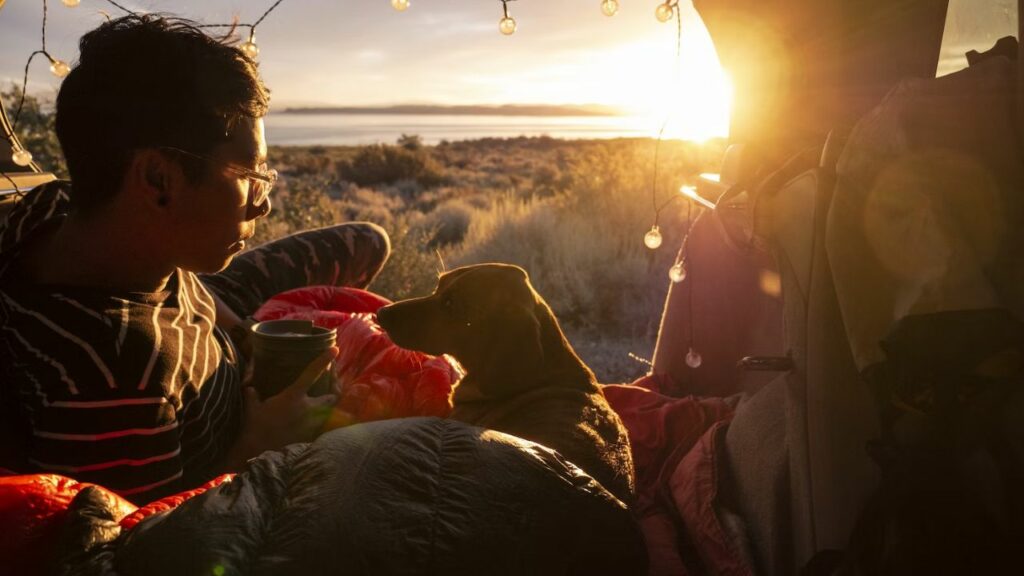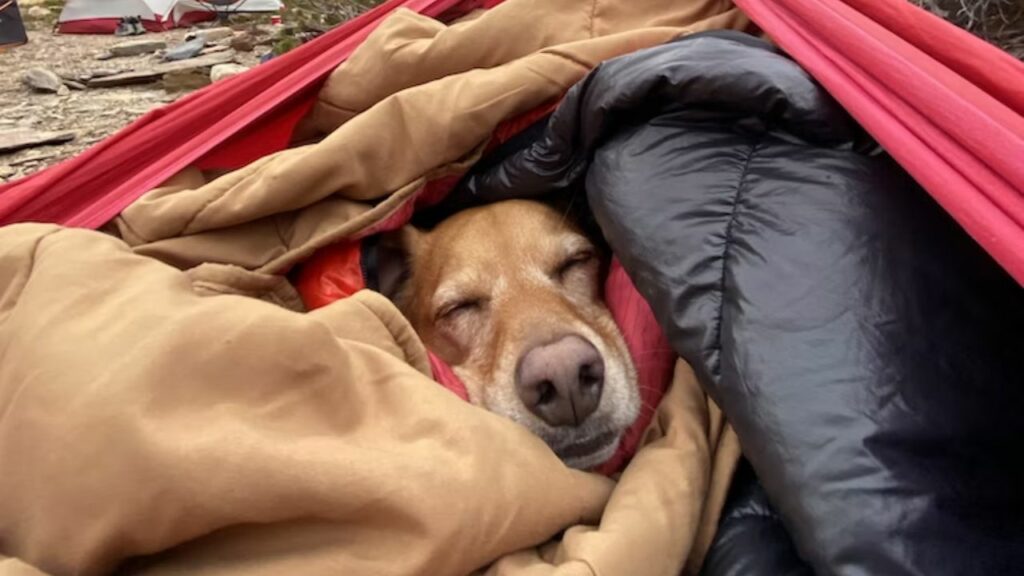Let me just start by saying that whatever you may have in mind about the issues and mess and whatnot. Don’t be. Camping with your dog is probably the best thing you’ll ever do for yourself! It’s super fun.
The fresh scent of pine, the rustle of leaves underfoot, and the joyous wag of your furry friend’s tail as they eagerly explore the wilderness – it’s a symphony of adventure waiting to be enjoyed.
Now that I have you hooked, camping with your dog requires extra preparation to ensure a safe and enjoyable trip. From choosing the right campsite to packing the essential gear, there are important considerations to remember.
Whether you have a seasoned camping canine or a first-time adventurer, I have you covered. Let the adventure begin!
Can I bring my dog for camping? Is it a good idea?
Generally speaking, most dogs can enjoy camping, but you must consider your dog’s temperament, energy level, and health. Some breeds are naturally more adventurous and adaptable, while others prefer a more relaxed environment. You could also consult with your vet for the ideal outcome.
While it’s hard to point out specific dog breeds, I can tell you there are 3 categories unsuitable for camping. First, senior or ill dogs. Second, new mutts haven’t yet broken in and completed their training. And third, puppies.
Here are some key points to ponder:
1. Veterinary Considerations and Health Check-ups
Before embarking on a camping adventure, visit your veterinarian for a thorough check-up. Ensure your dog is up-to-date on vaccinations and flea, tick, and heartworm preventatives. Discuss any specific concerns about your dog’s health and receive guidance on managing potential risks while camping.
My advice is to get some flea and tick prevention treatment. Additionally, groom them so they’re less likely to get infected with short hair. It’ll also keep your doggy cool.

2. Packing Essentials for Your Dog
Prepare a dog-specific camping kit with ample food, fresh water, and any necessary medications your dog may need during the trip.
Pack enough supplies to last the duration of your camping adventure, including bowls, a leash, a collar with identification tags, waste disposal bags, and a comfortable bed or blanket for your dog’s sleeping area.
How to prepare your dog for its camping trip?
Proper preparation ensures a smooth and enjoyable camping experience for your furry friend. Consider the following steps:
1. Introduce them to the equipment.
Before your trip, allow them to sniff and explore tents, sleeping bags, and other camping equipment. This familiarization process can help reduce anxiety and make them more comfortable during the camping experience.
2. Training and obedience commands.
Basic obedience training is essential when camping with your dog. Ensure they respond well to commands such as “sit,” “stay,” and “come.” Training promotes safety and enhances the overall experience by providing control in different situations.
3. Do mock practice drills in controlled environments.
Before venturing into the wilderness, practice camping skills with your dog in controlled environments such as your backyard or a local park.
Set up a small campsite and observe how your dog behaves outdoors. This practice run can help identify potential challenges and allow you to address them beforehand.
How to choose the right campsite and accommodations?

Selecting the perfect campsite is essential for a successful camping experience with your dog. And unfortunately, it’s quite different than choosing a campsite for yourself.
- Research dog-friendly campgrounds in advance, checking their policies regarding leash requirements, off-leash areas, and breed restrictions.
- Assess the campground’s terrain and climate to ensure it suits your dog’s comfort level. Dogs with shorter legs or mobility issues may struggle on rugged terrains or extreme temperatures.
- You should also consider amenities such as nearby water sources, shaded areas, and dog-friendly trails to enhance your dog’s camping experience.
- Look for campsites with open areas or nearby trails where you can take your dog on walks and provide them with mental and physical stimulation.
- Decide which camping option suits you and your dog best. Tent camping provides a more immersive outdoor experience, while RVs and cabins provide added comfort and convenience.
Essential Gear and Supplies for Camping with Your Dog
When camping with your dog, packing the right gear is crucial to ensure their comfort, safety, and enjoyment. Here’s a comprehensive list of essential and optional items:
1. Everything You Must Bring:
- Dog-friendly sleeping arrangements
- Leashes, collars, and harnesses
- Portable water bowls
- Waste disposal bags
- Doggie first aid kit
- Toys, treats, and comfort items
Bring your dog’s favorite toys and treats to keep them entertained and relaxed during downtime. Consider interactive toys or puzzles that provide mental stimulation.
2. Optional Items
If possible, you can bring the following items to enhance your dog’s comfort and ensure they enjoy the trip:
- Dog tent
- Dog sleeping bag
- Filter for water
- Weatherproof light-up collar or harness
- Cooling vest
Outdoor Activities and Adventures with Your Dog

Here are some activities to enjoy together:
1. Go hiking with your dog.
Take advantage of hiking trails near your campsite. Before hitting the trails, research dog-friendly trails and familiarize yourself with any regulations or leash requirements. Keep your dog on a leash or under voice control, and be mindful of other hikers.
2. Explore dog-friendly beaches, lakes, and swimming spots.
Ensure the area permits dogs and follows any posted rules. Keep an eye on your dog to ensure its safety in the water and be aware of currents or hazards that may be present.
3. Engaging in outdoor games and activities.
Dogs love to play, so bring their favorite toys or engage in activities that keep them active and entertained. Play fetch, frisbee, or engage in interactive games that encourage mental and physical stimulation.
How to keep your dog safe during the trip?
It’s important to be prepared for emergencies and have the necessary supplies. And to be honest, there’s a lot you can do, so let’s get started.
1. Keep them hydrated.
Dogs can easily become dehydrated, especially during outdoor activities. Ensure your dog has access to clean, fresh water at all times. Carry a portable water dispenser or collapsible bowl and offer water regularly.
2. Take preventative measures against parasites, insects, and wildlife.
Camping exposes your dog to lots of dangers. Use appropriate tick and flea preventatives, and consider bringing insect repellents formulated for dogs. Also, keep them away from wildlife.
3. Ensure your dog is supervised at all times.
Since I’m a worrywart, I have a backup plan for everything. So I usually bring a GPS collar. For the backup, my dog’s microchipped, so I can ensure their safety during the trip.
Additionally, you should keep your dog on a leash during most of the trip, especially when you’re busy doing something else.
4. Plan for emergencies.
1. Carry a basic first aid kit for pets. Familiarize yourself with basic dog first aid techniques, such as how to clean wounds, manage minor injuries, and recognize signs of distress.
2. Plan for unexpected situations with emergency contact numbers, including nearby veterinary clinics, animal hospitals, and poison control centers.
3. Depending on the nature of your camping trip and the distance from your home, it may be worth considering travel insurance that includes coverage for pet-related incidents.
By taking these precautions and planning for emergencies, you can ensure the safety and well-being of your dog during the trip.
Frequently Asked Questions (FAQs)
1. Is it safe to bring my dog camping?
Camping can be safe for dogs when proper precautions are taken. Ensure your dog is up-to-date on vaccinations, has received necessary preventatives for parasites, and is protected against ticks and fleas.
2. What should I do if my dog gets lost while camping?
Ideally, you should take preventative measures to keep your dog from getting lost, such as using a secure collar with identification tags and microchipping your dog. If your dog goes missing, immediately notify the campground staff and fellow campers and search the area.
3. Where do dogs sleep when camping?
Dogs need a comfortable and designated sleeping area when camping, just like humans do. Many dog owners bring a dog-specific sleeping pad, bed, or blanket for their furry companion. Some pooches prefer sleeping inside the tent with you, while others may be more comfortable outside.
If your dog tends to wander or has a tendency to dig, consider using a dog crate or a portable dog tent to create a secure and cozy sleeping space.
4. Is camping stressful for dogs?
Camping can be exciting and potentially stressful for dogs as it introduces them to new environments, smells, and experiences. Some dogs may adapt quickly and enjoy the outdoor setting, while others may feel overwhelmed or anxious.
To help reduce stress for your dog, it’s important to prepare them beforehand. Gradual exposure to camping-related equipment and activities in a controlled environment can help familiarize them with the camping experience.
Providing a comfortable and secure sleeping area, bringing familiar toys or bedding, and maintaining a consistent routine can also help ease their anxiety.
5. Should your dog sleep in your tent with you?
Generally, you should let your dog sleep wherever they’re more comfortable – inside the tent with you or outside the great outdoors. It doesn’t make a big difference if they have a secure and warm shelter.

